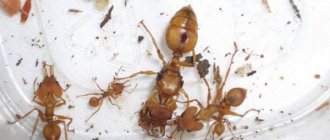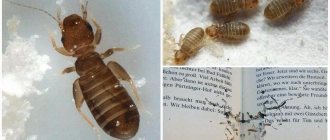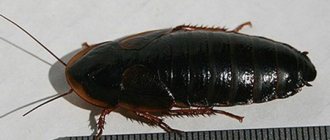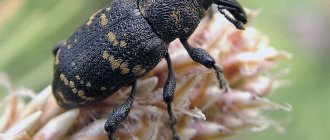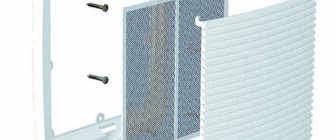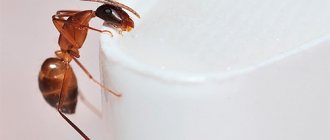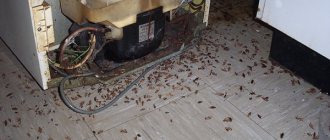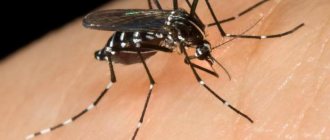What is the danger of fungus?
Not everyone knows what mold is and the harm it can cause to health. The fungus damages walls and cladding. The moldy fungus develops in colonies that destroy the wallpaper, the structure of the plaster as a result the walls turn black and begin to crack over time. If a fungus gets into a crack, it begins to attack the wall from the inside and then it will be almost impossible to overcome it.
The second negative aspect is the effect on the human body. Spores can enter through the respiratory system and remain inside until a suitable situation for their development is formed, for example, a decrease in immunity.
In rooms where fungus and mold appear there is often an unpleasant damp smell
Pathogenic microflora causes a number of diseases and symptoms:
- mycoses, dermatoses - fungal skin lesions
- dizziness, nausea, headaches
- vomiting, heartburn, bowel dysfunction
- pathologies of the musculoskeletal system
If you breathe in the fungus for a long time, chronic diseases of the cardiovascular system, kidneys, and liver develop.
How to make repairs in a damaged room?
Before you begin repairs in a fungus-affected room, you should remove all the furniture and put on a respirator and gloves. Then:
- You need to clean the walls well. Old wallpaper is removed, moldy plaster is cleaned down to concrete with a suitable tool.
- Remaining dust is washed away.
- All walls of the room are treated with an antiseptic (Biotol-spray, Mavix Bio, Dali) according to the instructions, then washed and dried. It is better to leave the surface for a day so that no excess moisture remains.
Painting is carried out in several stages : first, lay the first layer, which is allowed to dry completely. The second and subsequent layers are applied according to the same principle.
Reasons for appearing in the house
Fungal growth on the wall
Surfaces in a house or apartment can become moldy for various reasons:
- High air humidity, over 70%. Most often on loggias, balconies and bathrooms, where the fungus starts in the first place
- Insufficient insulation of walls, due to which they freeze in winter, and then thaw and become damp, creating an ideal microflora for the development of spores
- Improper insulation of the subfloor (especially in private homes). That is why it is recommended to make a screed and a “warm floor” to forget about dampness and mold
Spores can enter an apartment through water, air, people or animals. If the microflora is unfavorable for their development, then the walls will not bloom. But if the house is humid and damp, then the fungus will definitely find a secluded place in a corner or on the ceiling and begin to develop intensively.
In winter, when the glass sweats, condensation drains from it and moisture collects on the windowsill below, which often causes mold to appear.
They love plaster, wallpaper, tiles, stone, and grow on tile joints
The main signs are the formation of black and gray spots. The smell of mold is damp, reminiscent of amber from cellars.
It is important to determine the cause and remove it , otherwise the fight against fungal organisms will be ineffective.
Bleach against fungus
- excellent option for smooth surfaces (ceramic tiles, glass) or concrete;
- not suitable for finishing plasterboard;
- requires careful use.
What do we have to do
- clean the wall surface from mold;
- pour chlorine powder with water in a concentration of 1 to 10;
- keep the solution for 24 hours;
- Apply the resulting solution with a spray bottle or roll a roller soaked in a container over the wall.
Be sure to use rubber gloves to prepare the solution - and in general to clean the walls in the apartment - and cover your respiratory tract if possible: chlorine vapors can cause severe irritation of the mucous membranes or an allergic reaction.
Main types of mold
Another example of fungal infection in the bathroom
Mold or mildew is a general name, but they are divided into subspecies, each of which appears for its own reason and has certain characteristics and harm. Different species need to be treated differently.
Types of mold:
- Black fungus is the most common type that affects walls, ceilings and floors in houses and apartments. It affects not only natural materials, but also brick, iron, tiles, lining, etc.
- Rotting fungi. This group includes white and brown mushrooms, which are grown exclusively in wood. They do not start on tiles or plaster. They are afraid of hydrogen peroxide, manganese and copper sulfate. The rotten part cannot be restored, therefore, in order to prevent rotting, wooden surfaces must be impregnated with Antifungal at least once a year for prevention
- Blue fungi , like the previous type, only grow in wood. It does not start in high-rise buildings; it can often be seen in wooden sheds, bathhouses or saunas. A weak solution of potassium permanganate or office glue in a 1/1 ratio with water helps to eliminate
Premium mold repellents
"Savo"
An effective Czech remedy for preventing the formation of fungus and eliminating mold. The main active ingredient – sodium hypochlorite – can successfully cope with any type of mold. The drug can be applied immediately, without prior chemical or mechanical treatment of the infected area. Available in spray form, which allows the solution to penetrate deeply into holes and crevices, thereby ensuring the best result. "Savo" can be used in rooms such as bathrooms, showers, saunas, swimming pools, basements and attics.
Before starting work, you must wear protective gloves and a respirator. "Savo" should be sprayed onto the surface from a distance of 10 cm, focusing on irregularities and crevices. Then, the applied composition should be left for 20-30 minutes, then rinsed with water. After complete drying, the surface can be re-treated if traces of contamination remain. Two treatments are usually enough to completely get rid of mold. If the area of infection covers large areas, and the treatment is carried out in a closed residential area, it is recommended to leave it for 1-2 days, since the drug has a strong chemical odor. With a small infection and a small treatment area, it is enough to ensure good ventilation of the room, or open the windows for ventilation.
The average cost is 1,020 rubles.
Savo against mold
Advantages:
- convenient release form;
- can be used for preventive work;
- effective and long lasting results.
Flaws:
- strong smell;
- high price.
"Fongifluid Alpa"
Russian antifungal agent for destroying all types of mold, moss and lichen from wooden surfaces. It is used for the prevention and treatment of rooms with high levels of humidity: bathrooms, steam rooms, saunas, showers, basements, greenhouses, as well as buildings exposed to moisture - fences, fences, outdoor structures made of wood. Suitable for processing various materials: plaster, concrete, brick, plasterboard, natural stone, ceramics, tiles. The drug penetrates deeply into the treated area, while it does not form a film and does not distort the color of the surface. The product contains no harmful chemical components or toxins, it is safe and environmentally friendly.
"Fongifluid Alpa" is completely ready to work and does not require breeding. If the infestation is old or severe, it is recommended to apply the solution twice. After application, it must be left until completely dry (4 to 6 days).
The average cost is 1,650 rubles.
Fongifluid Alpa
Advantages:
- carefully cleans the surface;
- does not leave streaks;
- is produced in finished form.
Flaws:
- high price.
Ways to fight fungus
Treating mold with a special product
Black fungus can be easily wiped off with a damp sponge, especially from smooth surfaces, but this does not solve the problem. To get rid of it, you need to take drastic measures, disinfect surfaces and eliminate spores.
If you do not eliminate the cause, but simply mechanically wipe away the black marks during cleaning, they will not disappear anywhere and the fungus will multiply more and more.
Removing fungus with a brush
To remove mold and colonies of fungal microorganisms, it is necessary to wet the infected surface with the product and leave it to act for several minutes. This is necessary to prevent fungal particles from getting into the air. Then you need to take an elastic brush and clean the blackness.
If you are cleaning mold from plaster, you need to capture as large a layer as possible - up to 1 mm, in order to clean off all the bacteria that have become embedded in the wall. This method is not effective on smooth surfaces.
Or rather, you can wash it with a rag, but it is important to use disinfecting chemicals that will completely eliminate mold residues that are not visible to the naked eye.
If fungi have penetrated deep into the walls, then a major repair using antifungal impregnation will be an effective way.
Traditional methods
Dilution of copper sulfate
These methods are based on the use of improvised means, but have been tested over the years:
1 Acetic acid is a strong disinfectant. To remove mold from smooth surfaces, simply wipe them with a sponge soaked in acid. For concrete or wooden walls, it is better to use a spray bottle for treatment. Spray the product onto the black spots and leave for several hours. After this, clean the remaining fungus with a brush and treat the surface with clean water.
2 Active foam. Active foam can be used for tiles and grout. It is prepared on the basis of acetic acid and baking soda, which also has antibacterial properties. In a container with a spray bottle you need to mix a glass of water and a couple of drops of liquid soap or washing gel, 2 tbsp. l. extinguish the soda with vinegar and move everything, shaking until foam appears. If desired, add citric acid or juice - 1 hour. Then it is applied to the tiles with a sprayer, left for 15 minutes and washed off with a sponge. This method eliminates many types of contaminants, hard water deposits, odors and kills many pathogens.
3 The use of hydrogen peroxide destroys pathogenic microflora no worse than other means. A bottle in a pharmacy costs a penny. You can spray it on the windows and corners of the apartment with a spray bottle and leave it for a few minutes for the drug to take effect.
Tea Tree Essential Oil
4 Tea tree oil helps disinfect and remove unpleasant odors. It is applied with a sponge to places where fungal colonies multiply. You can use lavender and rosemary aromatic oils in the same way.
5 Chlorine . You can use any product that contains chlorine. The most effective is Whiteness. It can be applied to the wall in its pure form or diluted with water in a ratio of 1/1. It is important to remember that this is bleach and it eats away the color, so before applying it to the wall, you can slightly undermine the wallpaper so as not to ruin it. Bleach can be used to clean plumbing fixtures and tiles in the kitchen and bathroom for preventative purposes.
6 Ammonia also has antibacterial properties and is suitable for eliminating pathogenic microflora. Can be used for windows, concrete or drywall slopes. When using, ventilate the room well, because ammonia has a pungent odor. It is mandatory to carry out work wearing gloves and goggles. You need to work on a dry surface
Grapefruit Seed Extract
7 Grapefruit seed extract is an effective anti-fungal drug. Allows you to remove mold from walls, removes fungus on the skin or nails. Widely used in agriculture, cosmology, traditional and alternative medicine. They are sold in small bottles and have an oily structure. For 1 liter of water you need 15 drops of extract, mix thoroughly and apply with a brush or sponge to the affected areas and the spread of black spots.
8 Copper sulfate, which can be purchased at a hardware or hardware store, will help remove mold and mildew from the walls in your apartment. It costs a penny, but has a powerful antibacterial effect. The vitriol is diluted before use, at a rate of 10 grams per 1 liter of warm water. Some people recommend wiping off the mold with a sponge or spatula first, but it then gets into the air, so it’s better not to do this. To remove mold, apply the vitriol solution with a brush or sponge. You need to let the surface dry for 5-7 hours and repeat the procedure. The number of repetitions directly depends on the condition of the wall. If there is a little mold there, then 1-2 times is enough. When working with vitriol, it is advisable to remove children and animals from the house and ventilate the premises completely (to avoid poisoning)
Chemicals
Using chemicals against fungus
Modern technologies make it possible to produce chemicals that destroy pathogenic microflora, but at the same time they are not harmful or toxic:
1 Anti-mold is an antifungal emulsion that is used against all types of fungi. It has many advantages: it is applied without preliminary cleaning of the surface, the result is within half an hour after application, the effect lasts up to several months. The composition includes chlorine, water and microelements, which additionally have an antibacterial effect and help remove odors. Blackheads disappear almost completely, because the product has whitening properties. If they remain after application, you can reapply the product.
2 Mil Kill is an antiseptic solution, recommended for use on porous surfaces. This is a primer and is used in the process of construction and repair work. Does not have a pungent odor. It can be used to treat walls, pools, tiles to remove fungus
3 Isocide are cleaning products, that is, a number of chemicals that are used to destroy microflora (used in everyday life and in construction)
"HG" product
4 “HG” product – disinfects and quickly kills fungus, mold, algae, moss and other microorganisms in places with high humidity both indoors and outdoors. Can be used for baths, sinks, toilets, showers, tiles. The product is applied to the stain for 10 minutes and washed off with clean water. If stains remain, the procedure can be repeated.
5 Dali is a universal antiseptic that removes all types of fungi - white rot, gray mold, brown fungi, moss, etc. Recommended for porous surfaces, as it has the property of penetrating deep into materials. There is no chlorine in the composition, but the product helps get rid of the unpleasant odor
Specialized products can effectively get rid of stains, but before using any of them, you must carefully read the instructions and follow all precautions.
We also recommend using impregnation or a special primer during repairs. Treating your walls before applying paint or wallpaper will help protect against mold for years to come.
Professional cleaning of the premises
Ionization and sanitation
To guarantee the elimination of fungus in the shortest possible time, it is better to contact professionals who, using special chemical equipment, will eliminate all microbes, fungi, and bacteria within 1 day.
Sanitation stations and cleaning companies provide sanitation and ionization services. The impact on mold stains occurs through a flow of air enriched with ions and microelements.
If the problems are large-scale, then the walls are first treated with chemicals and then cleaned with an ionizer.
How to remove mold on walls
We often fight mold instead of dealing with dampness. Mikhail Zhvanetsky is a satirist writer.
To defeat the fungus, you need to eliminate the causes of its appearance. You need to get rid of high humidity in the apartment. Repair ventilation, replace leaking pipes, eliminate leaks on the roof, properly insulate the walls.
Before removing mold on the walls with special means, it must be washed off with plain water. For washing you can use brushes, sponges, rags. These steps will prevent the spores from spreading into the air.
Then you need to clean the surface of the wall. You can use scrapers, metal brushes, a drill with a metal brush. The deeper the mold has penetrated, the deeper the wall must be cleaned.
Treat the walls with a special anti-mold agent. When choosing a special product, you need to take into account the material of the wall surface. Be sure to follow the instructions on the packaging of the product.
The spread of mold mycelium may be invisible to the human eye. Therefore, the affected areas of the wall must be treated with a margin of up to one meter.
A wall affected by mold should be treated several times. Each new layer of antifungal drug should be applied only after the previous layer has dried.
When cleaning a surface from mold, be sure to clean the adjacent surface.
What to do if mold spores have penetrated deeply into the structure of the material
In the depths of porous materials, the mold fungus forms the main mycelium. Surface treatment of such areas does not produce results.
Visible mold on the walls can only be removed for a while. The spores will germinate again and form new mycelium.
If it is possible to completely replace the affected part of the wall sheathing, it makes sense to do so. Or you will have to scrape the damaged surface to the deepest layers.
Compliance with safety regulations
Both mold and chemicals can be absorbed through the air into your respiratory tract. To prevent this from happening, you must follow safety rules. You should also not allow certain substances to come into contact with your skin, such as copper sulfate.
Safety regulations:
- Be sure to use rubber gloves to protect the skin of your hands and nails
- a mask, goggles and a respirator will protect the face and respiratory organs from harmful fumes of household chemicals and fungal spores that fly in the air
- a full-body robe or suit must be worn when treating surfaces at height, for example, when applying the product to the ceiling
Mid-price mold repellents
Pufas AMSS
A highly effective product from a German manufacturer that can clean the infected area almost instantly. Possessing a powerful effect, the drug does not contain chlorine. The wide range of applications of the product includes rooms such as the kitchen, bathroom or shower room, toilet, balcony, building basement, facade, attic space and roof. Pufas AMSS does not spoil the material it is applied to, so it can be used to disinfect decorative elements. Also, the product can be used as a preventive measure during construction or finishing work.
Available in convenient packaging with a built-in spray bottle. Before work, you need to ensure your safety by wearing safety glasses and gloves. It is recommended to spray the drug onto the treated area from a distance of 20 cm. It is necessary to completely saturate the surface with the solution, and then leave it until completely dry (3 days). If, after this period, traces of mold remain on the area, the procedure should be repeated without washing off the solution. The remains of the drug are washed off with water.
The average price is 473 rubles.
Pufas AMSS
Advantages:
- fast action;
- convenient packaging;
- long-lasting and reliable protection.
Flaws:
- high price.
"Olympus stop mold"
A product from a Russian manufacturer that creates long-lasting and reliable protection against fungal deposits. It has a wide range of applications, can be used in wet rooms: bathrooms, showers, saunas, swimming pools, as well as basements, basements and attics, facades and roofs of buildings. Using "Olympus Stop Mold" you can eliminate fungus from concrete, tiled, natural stone, brick, wood and plaster surfaces. At the same time, the drug is harmless to humans and pets, since the composition does not contain chlorine or harmful volatile substances. Also, it does not change the color and texture of the treated surfaces.
Before starting disinfection, you must first remove the layer of fungal plaque, check whether old paint, plaster and other materials are peeling off - the surface should be as smooth as possible and not contain large particles of debris. The solution is available ready-made; it does not need to be further diluted with water. “Olymp Stop Mold” is applied using a brush, roller or spray (at a distance of 20cm). To achieve the best result, it is recommended to apply two layers of the product. The product dries completely within a day.
The average price is 479 rubles.
Olympus stop mold
Advantages:
- attractive price;
- safety;
- high efficiency;
- convenient packaging;
- no smell.
Flaws:
- not detected.
"Dali"
Russian universal preparation suitable for use on surfaces made of wood, concrete, brick and plasterboard. It is able to penetrate deep inside, even under a layer of plaster, which eliminates the need to remove it before starting work. The drug does not contain chlorine, making it harmless for people prone to allergic reactions. "Dali" is quickly absorbed and does not spoil the appearance of the materials.
The solution can be applied using a roller, wide brush or spray. You should also follow safety precautions, use a respirator and protective gloves. The processing temperature should be no lower than 5 degrees Celsius. “Dali” demonstrates high penetrating ability; it dries completely within 24 hours. If the surface is heavily contaminated, it must first be cleaned mechanically, rinsed thoroughly with water and dried completely. Remove any remaining dirt with a brush after two days of drying.
The average price is 580 rubles.
Dali against mold
Advantages:
- penetrates deeply into the material;
- fast absorption;
- does not spoil the color and texture of materials.
Flaws:
- has a strong chemical smell.
"Sazi Wepost Luxe"
A Russian-made antifungal agent that can be used indoors and outdoors. The manufacturer recommends using the product in combination with a water repellent to provide protection from the harmful effects of dust and moisture - after its application, a thin, invisible layer remains on the surface, preventing the penetration of dampness. Thanks to this, the solution-treated material increases the level of waterproofing.
Disinfection is carried out in two stages. At first, the antiseptic included in the composition deals with the destruction of mold. The product must be left until it dries, then reapplied according to the instructions, and then remove the residue with a scraper. At the second stage, it is recommended to apply a water repellent for reliable protection from the negative influence of the external environment. "Sazi Wepost Luxe" has a long-lasting effect.
The average price is 750 rubles.
Sazi Wepost Luxe against mold
Advantages:
- does not spoil the appearance of materials;
- increases moisture protection;
- prevents the reappearance of the fungus.
Advantages:
- not found.
Mold prevention
Preventive methods will help avoid the appearance of fungus. The first method must be carried out at the stage of construction and repair work. This is the treatment of surfaces with antibacterial impregnation or primer with antifungal properties.
It is also necessary to regularly clean wet areas in your home.
The second condition is high-quality ventilation and regular airing of the room. In addition, you need to inspect your home for mold from time to time. Most often it appears in rooms with high humidity - bathrooms, kitchens. Mold also “loves” the corners of balconies and walls behind bulky furniture.
Experts do not recommend placing furniture close to walls and corners so that they are well ventilated - this reduces the risk of fungi.
In summary, it should be noted that mold not only spoils the aesthetics of the room, but also negatively affects the health of household members. To avoid it, you need to ventilate the room daily, clean it 2-3 times a month using disinfectants (they not only kill germs, but also fungal spores). Home remedies that don't require a lot of money can help you get rid of stains.
VIDEO: HOW TO GET RID OF FUNGUS ON WALLS
Where does mold on walls come from?
Mold appears on walls when only three conditions are met.
First: mold spores must be present in the air. Microspores can enter the house in any way: on outer clothing, on the fur of pets, with air flow, with things brought in.
Second, mold is a life form and requires organic food. Mold needs organic food, so it can live anywhere and eat literally everything: dirt, soil, paper, fabric, stone.
Third: mold on walls responds positively to high humidity. If the room temperature is +20° and the humidity is from 70 to 95%, mold spores rejoice!
Fungal spores germinate when there is uneven heating in the room, faulty ventilation and dirt deposits in the corners. Some types of fungi can live and reproduce even at 0°C.
Read our special article about how to save heat in an apartment or house >>
1 Savo
Convenient packaging of the drug allows you to most effectively treat surfaces of different quality and curvature. Approved for use to prevent mold formation. The active ingredient is sodium hypochlorite. Copes well with fungal contamination in saunas, swimming pools, basements, and attics. No additional cleaning of contaminated surfaces is required before application. The main advantage of the drug is considered to be complete relief from the problem.
To calculate the amount of product for all surfaces, it is assumed that 50 mg is required per 1 m2 of area. Spraying is carried out no more than 10 cm from the surface, carefully treating cracks, thresholds, bulges, and pits. Leave for 20-30 minutes and rinse with water. After drying, a decision is made on the need for re-processing. Consumer reviews indicate that a two-time procedure is enough to get rid of mold forever.
